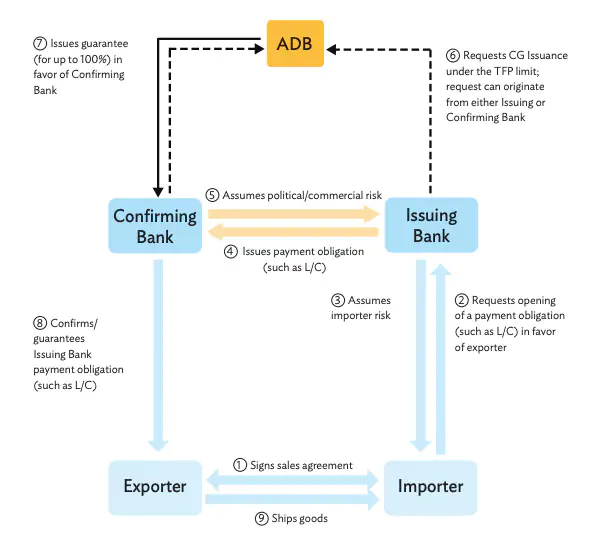Estimated reading time: 4 minutes
International trade is vital to the growth of income and the country’s economy. It is, however, not possible to carry out any trade devoid of any risks.
The Trade Finance Programme (TFP) of the Asian Development Bank (ADB) aims to bridge the trade gaps through trade instruments that assures the payments for the advising banks. On a macro level, TFP aims to create sustainable jobs and economic growth which is one of the objectives of ADB. On a micro level, the TFP aims to mitigate the risk arising out of buyers’ defaults of obligations in trade through its Credit Guarantee instrument.
Commercial risks in trade
The initial cost of the trade transaction is borne by the seller. This could be the cost of manufacturing, procurement, or maintenance of the stock of goods that is to be sold.
The risk associated with the buyer’s default of payment is subsequently attached to the international trade transaction as there is a possibility of loss of upfront cost and goods altogether.
The risk of the buyers’ failure to make payment for the goods is generally understood as a commercial risk. It is also called ‘purchaser risk’, as it arises from the default of the purchaser’s obligation.
It must be noted that while the commercial risk is largely attributed to the payment default of the buyer, it also extends to failure to carry out other obligations under the contract that is prerequisite to the trade transaction. Such prerequisites could be found in the buyer’s condition precedent before the seller dispatches the goods.
When exporting to a buyer in a developing country, the seller may also face higher commercial risk because of a lack of awareness of the creditworthiness of the buyer and/or reliable banking infrastructure to finance the trade on behalf of the buyer.
Credit guarantee under the TFP
ADB, a multilateral development bank established by the Agreement Establishing, aims to increase financing opportunities in Asia and to expand the external trade of its members. Accordingly, the ADB Charter provides an important trade-related function of ADB, requiring it to support its members to promote the expansion of foreign trade.
At present, the Credit Guarantee is available to partner issuing banks of ADB in 16 developing countries including Armenia, Cambodia, and Nepal. While ADB has financed trade worth $64.8 billion since 2009, 75% of its support comes from a single financial product, the Credit Guarantee.
Credit guarantee under the TFP typically involves two arrangements, as illustrated and discussed figure below:
3

Fig.: Credit Guarantee under TFP
Firstly, the primary financial arrangement in the arrangement is between the exporter, importer, issuing bank, and the confirming bank (no. 1-5, and 8). ADB does not have a direct relationship with the exporter and importer, but only with their respective banks.
Malaket notes that this is very akin to the ‘traditional Letter of Credit’, allowing the exporter to avail the risk mitigating factors associated with a letter of credit (LC).
The guarantee arrangement, identified as no. 6-7, involves three parties: the ADB acts as the guarantor, the issuing bank is the party being guaranteed, and the confirming bank is assured that it will receive 100% of the purchase price if the issuing bank defaults.
Eventually, the financial products issued by the banks to mitigate risks via the financial products are not substituted or replaced by the Credit Guarantee from ADB, but are rather given an added risk mitigating tool.
ADB’s Credit Guarantee as risk mitigating tool
As insinuated earlier, trade finance via ADB’s Credit Guarantee avails the safeguarding tools against commercial risks on two levels.
Firstly, the use of an LC removes the reliance on the buyer to make the payment for the goods. While the possibility of the seller being unaware of the buyer’s creditworthiness is higher, an LC by its nature shifts the payment obligation on the issuing bank which compared to the buyer would have higher creditworthiness.
The seller is assured of the payment via LC provided they are able to furnish the documents as required under the sales contract. The LC is independent from the sales contract, and the buyer cannot instruct the banks to withhold the payment
Secondly, the Credit Guarantee scheme also eliminates the commercial risk of the confirming bank that could arise from payment default of the issuing bank as the payment is guaranteed by ADB. It has been recognised that this increases the reliability of the LC issued by local banks in developing countries.
The Credit Guarantee facility within the TFP reduces the commercial risk for both the exporter and the confirming bank. This is particularly beneficial when conducting trade with buyers in developing countries that are associated with issuing banks partnered with the ADB.

































